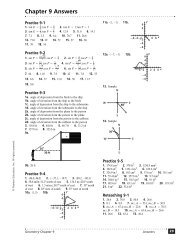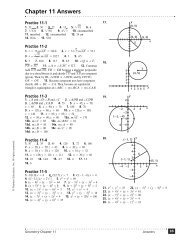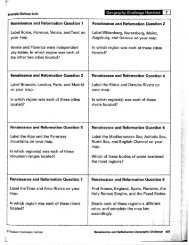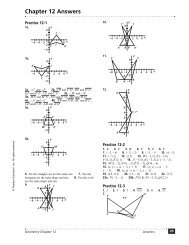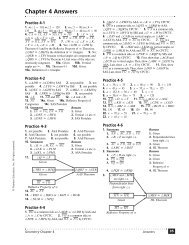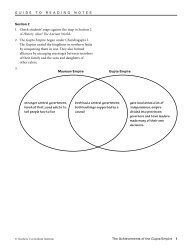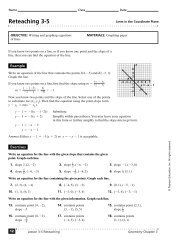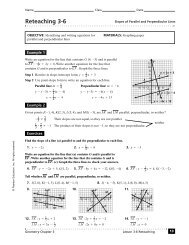Chapter 12 Sequences; Induction; the Binomial Theorem
Chapter 12 Sequences; Induction; the Binomial Theorem
Chapter 12 Sequences; Induction; the Binomial Theorem
Create successful ePaper yourself
Turn your PDF publications into a flip-book with our unique Google optimized e-Paper software.
<strong>Chapter</strong> <strong>12</strong> Cumulative Review<br />
3x<br />
x 2<br />
6. f ( x)<br />
= , g ( x) = 2x+<br />
1<br />
−<br />
a. g ( ) ( )<br />
f ( )<br />
( )<br />
2 = 2 2 + 1=<br />
5<br />
35 15<br />
5 = = = 5<br />
5−<br />
2 3<br />
( f g)( ) f ( g( )) f ( )<br />
b. f ( )<br />
2 = 2 = 5 = 5<br />
( )<br />
34 <strong>12</strong><br />
4 = = = 6<br />
4−<br />
2 2<br />
g ( 6) = 2( 6)<br />
+ 1=<br />
13<br />
( g<br />
f )( ) g( f ( )) g( )<br />
4 = 4 = 6 = 13<br />
c. ( f g)( x) = f ( g( x)<br />
)<br />
32 ( x + 1)<br />
=<br />
( x + ) −<br />
2 1 2<br />
6x<br />
+ 3<br />
=<br />
2x<br />
−1<br />
d. To determine <strong>the</strong> domain of <strong>the</strong> composition<br />
( f g)( x)<br />
, we start with <strong>the</strong> domain of g<br />
and exclude any values in <strong>the</strong> domain of g<br />
that make <strong>the</strong> composition undefined.<br />
g x is defined for all real numbers and<br />
( )<br />
( f g)( x)<br />
is defined for all real numbers<br />
except<br />
1<br />
x = . Therefore, <strong>the</strong> domain of <strong>the</strong><br />
2<br />
⎧ 1 ⎫<br />
composite ( f g)( x)<br />
is<br />
e. ( g<br />
f )( x)<br />
⎛ 3x<br />
⎞<br />
= 2⎜<br />
⎟+<br />
1<br />
⎝ x − 2 ⎠<br />
6x<br />
= + 1<br />
x − 2<br />
6x+ x−2<br />
=<br />
x − 2<br />
7x<br />
− 2<br />
=<br />
x − 2<br />
⎨xx≠<br />
⎬<br />
⎩ 2⎭ .<br />
f. To determine <strong>the</strong> domain of <strong>the</strong> composition<br />
( g f )( x)<br />
, we start with <strong>the</strong> domain of f<br />
and exclude any values in <strong>the</strong> domain of f<br />
that make <strong>the</strong> composition undefined.<br />
f ( x ) is defined for all real numbers except<br />
2 g f x is defined for all real<br />
x = and ( )( )<br />
numbers except x = 2 . Therefore, <strong>the</strong><br />
domain of <strong>the</strong> composite ( g f )( x)<br />
is<br />
{ x| x ≠ 2}<br />
.<br />
g. g ( x) = 2x+<br />
1<br />
1<br />
2<br />
y = 2x+<br />
1<br />
x = 2y<br />
+ 1<br />
x − 1=<br />
2y<br />
( x 1)<br />
− = y<br />
−<br />
g ( x) = ( x−<br />
1)<br />
2<br />
−1<br />
The domain of g ( x)<br />
1 1<br />
numbers.<br />
3x<br />
f x =<br />
x − 2<br />
3x<br />
y =<br />
x − 2<br />
3y<br />
x =<br />
y − 2<br />
x( y− 2)<br />
= 3y<br />
xy− 2x = 3y<br />
xy− 3y = 2x<br />
y( x− 3)<br />
= 2x<br />
2x<br />
y =<br />
x − 3<br />
−1 2x<br />
f ( x)<br />
=<br />
x − 3<br />
f<br />
h. ( )<br />
−1<br />
The domain of ( x)<br />
is <strong>the</strong> set of all real<br />
is { x| x ≠ 3}<br />
.<br />
7. Center: (0, 0); Focus: (0, 3); Vertex: (0, 4);<br />
Major axis is <strong>the</strong> y-axis; a = 4; c = 3 .<br />
2 2 2<br />
Find b: b = a − c = 16 − 9 = 7 ⇒ b=<br />
7<br />
Write <strong>the</strong> equation using rectangular coordinates:<br />
2 2<br />
x y<br />
+ = 1<br />
7 16<br />
Parametric equations for <strong>the</strong> ellipse are:<br />
x = 7cos π t ; y = 4sin π t ; 0≤t<br />
≤ 2<br />
( ) ( )<br />
<strong>12</strong>85<br />
© 2009 Pearson Education, Inc., Upper Saddle River, NJ. All rights reserved. This material is protected under all copyright laws as <strong>the</strong>y currently<br />
exist. No portion of this material may be reproduced, in any form or by any means, without permission in writing from <strong>the</strong> publisher.




